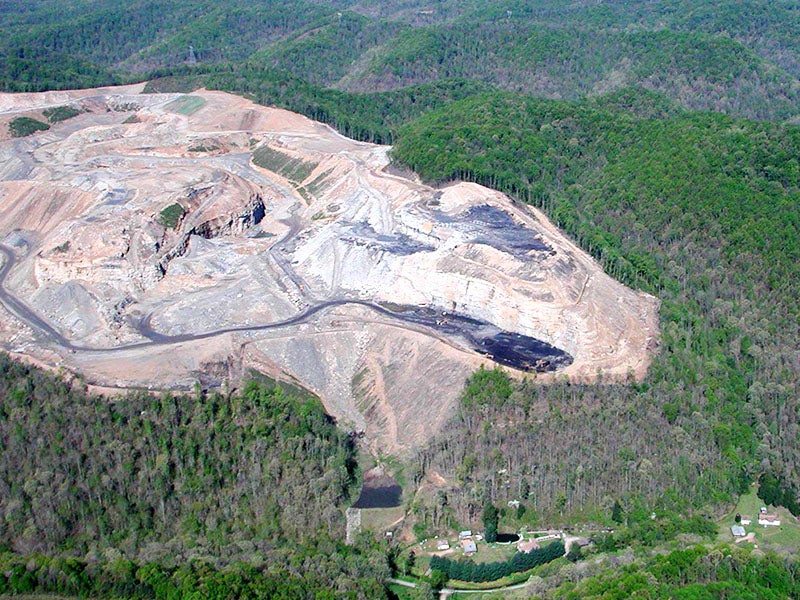Trump Stifles Science in Coal Country
The Trump administration doesn’t want us to know what’s making coal country sick.

This page was published 7 years ago. Find the latest on Earthjustice’s work.
President Trump loves to talk about the fictitious “War on Coal,” depicting the mining industry as a victim of environmental regulations. But what the administration is not acknowledging is the adverse impacts that coal has had, and continues to have, on the people living where it is mined, coal’s War on Communities.
The National Academy of Sciences was looking into this very issue until August 2017, when the Trump administration abruptly cancelled the study.
The Department of the Interior claimed the cancellation was part of an agency-wide review of large grants. But in June 2018, the inspector general’s office reported that it could find no criteria for the administration’s move. Around the same time, a Freedom of Information Act request from Pacific Standard magazine revealed that an official at DOI pushed for the study to be cancelled after meeting approximately half a dozen times with representatives of the coal industry and mining interest groups.
On July 25, with help from Earthjustice, Coal River Mountain Watch requested additional records on the Trump administration’s contacts with industry lobbyists prior to the study’s untimely end.
Canceling the study was “a slap in the face,” says Vernon Haltom, co-director of Coal River Mountain Watch. “It’s telling Appalachian people that their lives and health are not worth protecting.”
A long-time Earthjustice partner, Coal River Mountain Watch is located in West Virginia’s Coal River Valley. The organization had been requesting a study of this type for years.
An independent commission at the National Academy of Sciences was conducting the first comprehensive review of the science to examine potential health risks related to surface coal mining in Central Appalachia. The research had broad backing from the state of West Virginia and several members of Congress, but that didn’t protect it from yet another political attack on science.
Mountaintop removal mining is one of the most destructive processes in the extractive industry: Peaks of mountains are literally blown to smithereens to access the coal seams within. Even as employment in the coal industry has declined, the blasting has continued.
In areas with mountaintop removal mining, jagged, gray, open dirt pits replace the once rolling, green, forested mountain landscapes.
“Pictures and videos don’t give you the full effect,” Haltom describes. “You don’t know it until you see it in person. It’s one thing for places to be deforested or damaged, but to see places where I’d stood replaced with thin air … it’s so alien to human experience that it’s difficult for people to wrap their heads around it.” These mountains, this landscape, are central to Appalachian identity and heritage.
“Studies have found links between mountaintop removal mining and birth defects.”
Statistics on the health of residents living in Appalachia where surface coal mining occurs are not a pretty picture. Mortality from chronic cardiovascular disease and cancer is significantly higher than elsewhere, and studies have found links between mountaintop removal mining and birth defects. According to Haltom, in parts of Coal River Valley, you can stand in one yard and point to six different houses where someone has been diagnosed with a brain tumor—five of whom have died.
In fact, improvement in mortality rates in Appalachian coal-mining regions lag 24 years behind that of the rest of the nation. Haltom likens it to “watching the Grim Reaper come down your street. It’s weird going through Facebook and going ‘that person’s dead, that person’s dead, that person’s dead.’”
Several studies have found that areas with mountaintop removal mining have high levels of air particulates. The United States Geological Survey identified elevated levels of arsenic, as well as higher pH and conductivity, in streams near places where mountaintop removal mining was occurring.
Science is one of the few bulwarks against the “alternative facts” that have run rampant in current U.S. political discourse, which is why stifling this study is so dangerous. Cancelling this research is just one more example of an anti-science trend by the Trump administration and its allies in Congress, particularly regarding coal. Earlier this year, Congress repealed the Stream Protection Rule, a regulation that would have allowed for better toxicity monitoring of waterways in areas impacted by coal mining, using the Congressional Review Act. This information was sorely needed, especially considering 73 percent of all the drinking water treatment violations in West Virginia occur in counties impacted by mountaintop removal mining. Something needs to be done to protect clean water, but powerful polluter allies are actively preventing it.
Stifling science will not protect the health of coal miners or communities in Appalachia and other coal mining regions adversely affected by destructive coal mining practices. Residents of mining country deserve good jobs, and they also deserve clean air and water.
“Health studies seem abstract until people you know start dying,” Haltom says. Suppressing important research on the public health impacts of mountaintop removal mining achieves nothing. With this attack on science, the Trump administration prevents researchers from helping vulnerable communities identify and fight what is making them sick.
This blog post was originally published on September 21, 2017. It has been updated to reflect the findings of the inspector general’s office and Pacific Standard’s reporting, as well as Coal River Mountain Watch’s FOIA request.
Earthjustice’s Clean Energy Program uses the power of the law and the strength of partnership to accelerate the transition to 100% clean energy.
Earthjustice’s Washington, D.C., office works at the federal level to prevent air and water pollution, combat climate change, and protect natural areas. We also work with communities in the Mid-Atlantic region and elsewhere to address severe local environmental health problems, including exposures to dangerous air contaminants in toxic hot spots, sewage backups and overflows, chemical disasters, and contamination of drinking water. The D.C. office has been in operation since 1978.